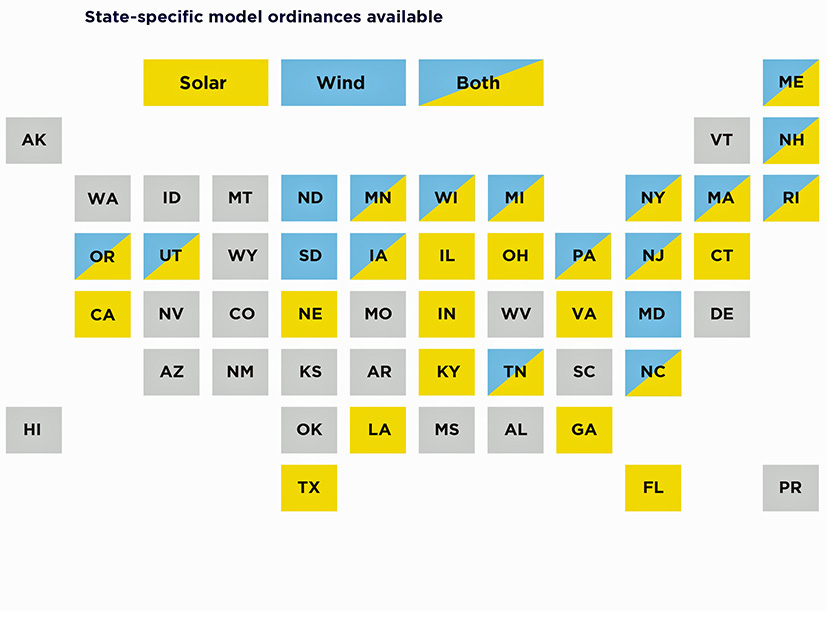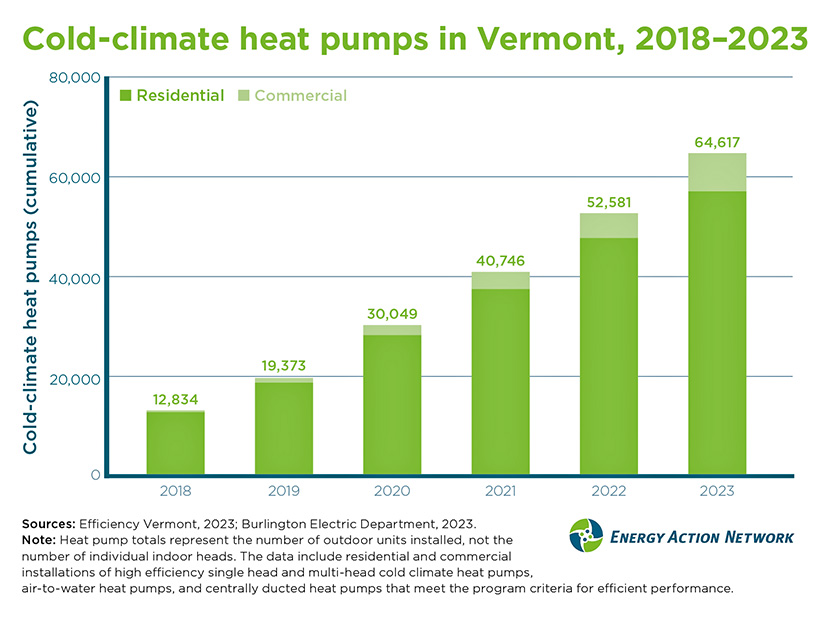The states that filed for a rehearing of FERC Order 1920 on transmission planning and cost allocation either argue the federal regulator is overstepping its authority or want changes to the order to ensure it doesn’t upset ongoing regional planning efforts.
Many states, or organizations that represent them, that commented earlier in the rulemaking process did not file for rehearing. But more than a dozen rehearing requests came into FERC from either states or organizations that represent multiple states, such as the National Association of Regulatory Utility Commissioners.
NARUC told FERC it appreciated the outreach to states during the rulemaking process and through task force meetings on transmission policy. But the group filed for rehearing because the final rule rejected some key provisions from the Notice of Proposed Rulemaking and adopted others that could undermine the goal of efficiently expanding the power grid.
“On rehearing, NARUC respectfully requests FERC address the necessary deference to and importance of the state agreement and consensus on planning and cost allocation issues outlined in the NOPR,” it said in a rehearing request filed last week. “The suggested changes will necessarily improve outcomes, reduce potential litigation and facilitate subsequent state siting proceedings associated with transmission projects.”
The NOPR proposed a stronger role for states in cost allocation, but FERC backed off that and requires only that states in a given region have six months to come up with their preferred cost allocation. The relevant transmission provider could decide to ignore that and file its own proposal.
The state agreement should be binding and subject only to FERC approval, NARUC argued. Transmission providers should have to detail their efforts on state outreach, and if FERC does not require its adoption, transmission providers should have to file details on any state agreement reached.
“Order 1920 creates a process that integrates individual state energy policies and goals into transmission planning, creates extensive procedures for ‘consultation’ with states and acknowledges how state input will facilitate the planning process,” NARUC said. “But then the order establishes conditions that permit the transmission providers to completely ignore and not even report upon state input.”
The majority on FERC pointed to a court precedent called Atlantic City in finding that transmission providers ultimately have the final say on whether to file cost allocation methods. The New England States Committee on Electricity argued that was not the case.
“However, Atlantic City does not prohibit commission action under FPA Section 206, under which authority the commission has promulgated Order No. 1920,” NESCOE said. “Rather, Atlantic City simply affirms that transmission-owning utilities have filing rights under Section 205 that FERC may not revoke.”
If FERC cannot grant rehearing on that, it should at least encourage transmission providers to voluntarily codify existing or new approaches that would put state alternatives before FERC, which would be consistent with the current practice in NYISO and SPP.
“Including the state-agreed-upon cost allocation method in a transmission provider’s Section 205 filing is a lawful and rational means to effectuate in a concrete way the respect for the state role the commission articulates,” NESCOE said. “The more the commission is successful in encouraging transmission providers to include such voluntary commitments in their tariffs, the greater the likelihood … that states in the region will have comfort with moving forward on providing the approvals needed to actually get much-needed new transmission built.”
The main thrust of NESCOE’s comments was that it did not want Order 1920 to mess with the implementation of recently enacted transmission planning rules where ISO New England has agreed with its state members on transmission plans that enact its members’ policies. FERC already has approved rules allowing the ISO to study scenarios developed with the states, but companion rules to competitively solicit actual transmission lines are pending. (See Stakeholders Support ISO-NE Long-term Tx Planning Filing, with Caveats.)
“NESCOE shares a commitment to meaningful, long-term regional transmission planning reform and seeks to ensure that FERC-jurisdictional transmission rates remain just and reasonable and not unduly discriminatory or preferential,” it said. “In light of the progress in New England, NESCOE especially appreciates the commission’s acknowledgment that certain transmission planning regions already conduct regional transmission planning on a forward-looking, proactive basis and its intent not to undermine progress made in these transmission planning regions, and our goal is to set a floor, not a ceiling.”
The Virginia State Corporation Commission and North Carolina Utilities Commission said they support the rule’s stated purpose and recognize the potential cost savings and reliability benefits that longer-term, comprehensive planning could provide to consumers. But they took issue with some aspects of the final rule, including its claim that states won’t subsidize others’ policies.
“Because the same public policies included in planning scenarios, and ultimately embedded in selected transmission projects, are not required to be considered for purposes of cost allocation, it is far from clear how that bedrock principle of just and reasonable rates can be actualized under the final rule,” the two said.
State policies like climate laws, which Virginia and North Carolina have enacted, are included in the long-term plan. But aiding their actual achievement is not among the benefits, so the state may pay too low a share for enacting its policy. The two suggested allowing transmission planners to do “baseline scenarios” that exclude state policies so it can be discerned how much the policies impact the other plans.
North Carolina and Virginia regulators also were skeptical of the proposal requiring utility and corporate “goals” to be included in the long-term transmission plans because they are easily changed, or even abandoned.
“This may ‘skew’ information submitted in the stakeholder process in favor of utility or corporate interests and result in planning scenarios that give too much weight to ‘goals’ that are unlikely to be achieved,” the SCC and NCUC said.
Other rehearing requests from states were more strident in their opposition to FERC’s Order 1920, arguing the commission overstepped its authority in the Federal Power Act and violated the “major questions doctrine.”
A group of Republican state attorneys general (from Texas, Alabama, Arkansas, Florida, Georgia, Idaho, Iowa, Kansas, Kentucky, Louisiana, Mississippi, Montana, Nebraska, North Dakota, Oklahoma, South Carolina, South Dakota, Tennessee and Utah) argued FERC is trying to use the planning and cost allocation rule to implement the Biden Administration’s green energy policies.
“It shifts transmission costs for those remote renewables to consumers under the guise that those consumers will ‘benefit’ from those resources, without considering whether less remote resources of any type might be less expensive, more reliable and environmentally beneficial,” the attorneys general said.
The filing was coordinated by the Texas Attorney General’s office, and it noted that the states aren’t opposed to renewable energy, with the Lone Star State leading the country in terms of megawatts of renewables installed.
“The commission’s claim that the rule’s proposals are necessary to ensure just and reasonable rates stretches the FPA beyond its limits,” the attorneys general said. “Indeed, the proposals set forth in the rule will not — and are not designed to — ensure just and reasonable rates; they are blatantly preferential and would harm consumers by shifting costs to load, not protect them.”
A group of state regulators used language similar to those attorney generals, with the Louisiana PSC, Mississippi PSC, Arkansas PSC and South Dakota PUC also arguing that while they are not against renewable energy, they are opposed to Order 1920’s usurpation of state authority.
“The commission is attempting to do indirectly what it is prohibited from doing directly: usurp the states’ exclusive authority over generation choices by instituting planning rules designed to benefit remote generation, and that generation’s developers, over local generation and to shift billions or trillions of dollars in transmission costs from those developers onto electric consumers,” they said.
The Arizona Corporation Commission said the order violates the major questions doctrine and would preempt its authority, while “unmistakably promoting a ‘net zero’ policy agenda.”
“The final rule seeks to recast FERC as a national integrated resource planner with extraordinary powers to oversee and dictate to all public utility transmission providers in the country, in RTO and non-RTO regions, detailed instructions on planning transmission that fulfills the current presidential administration’s stated preferred policies,” the ACC said.
The West Virginia PSC was more moderate in its criticism, noting that it supported the NOPR, but FERC’s decision to pare back state regulators’ input over cost allocation made the longer-term planning horizon and new mandatory benefits no longer just and reasonable.
“That substitute, the engagement period and de minimis requirements placed on transmission providers, is so far removed from state cost allocation involvement that was noticed that the cost allocation and state agreement requirements in the final new rules must be re-noticed to give the public an opportunity to comment,” the PSC said.
West Virginia is a member of the Organization of PJM States Inc., which filed its own rehearing request, also arguing states should have more of a guaranteed say over cost allocation.
“If states, through the process envisioned and required by the commission, exert the effort and resources to successfully reach agreement on a cost allocation method or methods and transmission providers are not required to file or even acknowledge the relevant state entities’ efforts, state engagement in the development of cost allocation methods for long-term regional transmission facilities and any expected development of more efficient or cost-effective facilities may never materialize,” OPSI told FERC.
In other words, giving states more authority would make them more likely to actually get steel in the ground.
OPSI was one of several organizations that argued the six months to come up with a state agreement could easily prove too short, given state regulators’ other responsibilities. FERC should allow for an extension to 12 months total if states unanimously agree that would help them come up with cost-allocation rules.
The PUC of Ohio’s Federal Energy Advocate filed comments noting that while the state has found RTO membership beneficial so far, Order 1920 could change that. RTO membership was based on assuring reliable transmission systems at the least cost.
Order 1920 “puts these principles in the rear-view mirror,” the Ohio regulator said. “Instead, it attempts to look 20 years into the future to launch a massive program today, not focused on achieving reliability at just and reasonable rates, but rather on building transmission projects to satisfy the ambitions, goals and policies of corporations, developers and governments that are not connected to reliability. Nothing could be further from the principles of Order No. 1000 and the requirement under the FPA for the commission to ensure just and reasonable rates.”
The Ohio commission supports the use of the existing State Agreement Approach, which so far has been used only by New Jersey, where PJM planners helped it save money on interconnecting the wind farms called for by its policies. But the rehearing request argued that would no longer be feasible under Order 1920 because the SAA is focused on state policies alone and ignores other benefits the lines produce — limiting cost allocation to the states that agree to it.
The Ohio regulator noted that New Jersey has decided to pause on moving forward with another use of the SAA as the Garden State weighs the implications of Order 1920.
“FERC must not let RTO membership devolve into an instrument by which states are pitted against one another in a zero-sum game of cross subsidies amongst competing policy interests,” the Ohio commission said. “Such a development would undermine the value proposition of RTO membership for states who do not wish to subsidize the policy preferences of others, directly contradicting FERC’s goal of encouraging RTO participation as envisioned by FERC Order No. 2000.”

